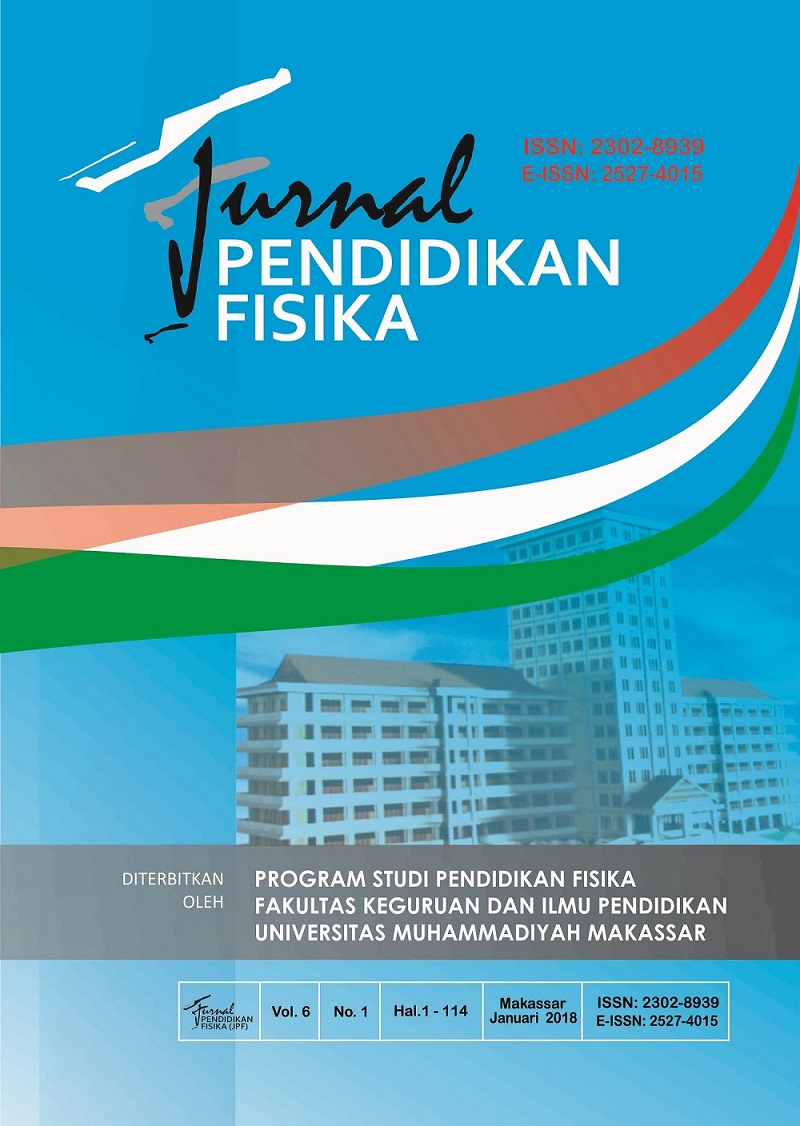Perbandingan Model Pelatihan dengan Model Pengajaran Langsung terhadap Hasil Belajar Fisika pada Siswa Kelas XI MAN 1 Buton Selatan
DOI:
https://doi.org/10.26618/jpf.v6i1.1198Abstract
Penelitian ini bertujuan untuk: (1) untuk mengetahui hasil belajar Fisika yang diajarkan dengan menggunakan Model Pelatihan pada siswa kelas XI MAN 1 Buton Selatan, (2) untuk mengetahui hasil belajar Fisika yang diajarkan dengan menggunakan Model Pengajaran Langsung pada siswa kelas XI MAN 1 Buton Selatan, (3) untuk mengetahui perbedaan hasil belajar Fisika yang diajarkan dengan menggunakan Model Pelatihan dan Model Pengajaran Langsung pada siswa kelas XI MAN 1 Buton Selatan. Hasil penelitian menunjukan bahwa: (1) besarnya hasil belajar Fisika siswa XI IPA1 MAN 1 Buton Selatan dengan menggunakan Model Pelatihan secara rata-rata sebesar 86,36 berada dalam kategori baik, (2) besarnya hasil belajar fisika siswa kelas XI IPA2 MAN 1 Buton Selatan dengan menggunakan Model Pengajaran Langsung secara rata-rata sebesar 82,26 berada dalam kategori baik, (3) terdapat perbedaan yang signifikan antara hasil belajar fisika siswa yang diajar dengan menggunakan model pelatihan dan model pengajaran langsung dapat dilihat dari analisis deskriptif yang berbeda. Hal ini menunjukan bahwa penerapan model pelatihan lebih efektif dibandingkan dengan model pengajaran langsung dilihat dari hasil belajar setelah diberi perlakuan.
Kata kunci: Model Pelatihan, Model Pengajaran Langsung, Hasil Belajar Fisika.
This study aims to: (1) to find out the results of learning Physics taught by using the Training Model in the students of class XI MAN 1 South Buton, (2) to know the results of Physics learning taught by using the Direct Teaching Model on students of class XI MAN 1 Buton South, (3) to know the difference of Physics learning result which is taught by using Model of Training and Model of Direct Teaching at student of class XI MAN 1 South Buton. The results showed that: (1) the amount of students' physics learning outcomes XI IPA1 MAN 1 South Buton using the Training Model on average of 86.36 are in good category, (2) the amount of physics learning result of grade XI IPA2 MAN 1 Buton South by using the Direct Teaching Model on average of 82.26 are in either category, (3) there is a significant difference between the students' physics learning outcomes taught by using the training model and the direct teaching model can be seen from different descriptive analyzes. This shows that the application of the training model is more effective than the direct teaching model seen from the learning result after being treated.
Keywords: Training Model, Direct Teaching Model, Physics Learning Outcomes.References
Ahmadi, K. I dan Amri, S. (2010) Proses Pembelajaran Kreatif dan Inovatif Dalam Kelas, Jakarta:PT. Prestasi Pustaka.
Danial. M dan Dkk. (2013) Perbandingan Hasil Belajar Siswa Yang Diberi Tugas Rumah dan Kuis Pada Model Pembelajaran Langsung: Jurnal Chemica Vol. 14 Nomor 1
Jalil, dkk, (2015) Perbedaan Hasil Belajar Fisika Dengan Penerapan Model Pembelajaran Jigsaw Dipadu Teknik Mencatat Mind Map Dan Model Pembelajaran Direct Instruction Pada Materi Dinamika Partikel. Jurnal fisika Volume 1V
Komara Endang. (2014) Belajar dan Pembelajaran Interaktif, Bandung : PT. Refika Aditama
Mulyasa.(2012) Kurikulum Berbasis Kompetensi, konsep Karakteristik, Implementasi, danInovatif : Bandung : PT. Rosdakarya.
Mundilarto, (2015) penilaian hasil belajar fisika. Surabaya: PT UHY
Musbir, (2015) Perbandingan Prestasi Belajar Siswa Yang Diajarkan Dengan Menggunakan Metode Think Pair Share dan Metode Pembelajaran Langsung: Vol V1 Nomor 1
Republik Indonesia, UU RI No.20 Tahun 2003 Tenteng sistem Pendidikan Nasional, Bandung: Fokusmedia.
Sardiman, (2009) Interaksi dan Motivasi Belajar Mengaja, Jakarta : PT. Raja Grafindo Persada
Sirait. R dan Sahyar (2013) Analisis Penguasaan Konsep Awal Fisika dan Hasil Belajar Fisika Pada Pembelajaran Menggunakan Model Inquiri Training. Medan: Jurnal Pendidikan Fisika
Sugiyono, (2015) Metode Penelitian Pendidikan Pendekatan Kuantitatif, Kualitatif, dan R&D, Bandung: Penerbit Alfabeta.
Sukmadinata, (2015) pembelajaran inovattif berorientasi kontruktifistik, Jakarta: Prestasi pustaka.
Wena, Made. (2014) Strategi Pembelajaran Inovatif Kontemporer, Jakarta Timur : PT.Bumi Aksara.
Widiasworo Erwin.(2017) Strategi dan Metode Mengajar Siswa di Luar Kelas, Jakarta : PT, Ar-Ruzz Media
Downloads
Published
Issue
Section
License
Copyright:
Authors who publish with this journal agree to the following terms:
1. Authors retain copyright and grant the journal right of first publication with the work simultaneously licensed under a Creative Commons Attribution-ShareAlike 4.0 International License that allows others to share the work with an acknowledgement of the work's authorship and initial publication in this journal.
2. Authors are able to enter into separate, additional contractual arrangements for the non-exclusive distribution of the journal's published version of the work (e.g., post it to an institutional repository or publish it in a book), with an acknowledgement of its initial publication in this journal.
3. Authors are permitted and encouraged to post their work online (e.g., in institutional repositories or on their website) prior to and during the submission process, as it can lead to productive exchanges, as well as earlier and greater citation of published work.
Licence:
Authors are free to:
1. Share: Copy and redistribute the material in any medium or format
2. Adapt: Remix, transform, and build upon the material for any purpose, even commercially.
The licensor cannot revoke these freedoms as long as the authors follow the license terms, which include the following:
1. Attribution: You must give appropriate credit, provide a link to the license, and indicate if changes were made. You may do so in any reasonable manner, but not in any way that suggests the licensor endorses you or your use.
2. ShareAlike: If you remix, transform, or build upon the material, you must distribute your contributions under the same license as the original.
3. No additional restrictions: You may not apply legal terms or technological measures that legally restrict others from doing anything the license permits.
Jurnal Pendidikan Fisika is licensed under a Creative Commons Attribution-ShareAlike 4.0 International License.

